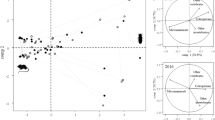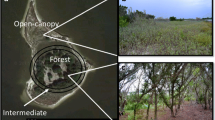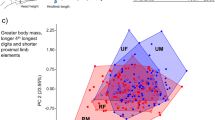Abstract
Body size is a key trait linked to many aspects of an organism’s life history, physiology, and behavior. Variation in body size can thus have important fitness consequences across a broad range of ecological contexts. We utilized the variation in multiple abiotic and biotic factors found among urban habitats to test simultaneously their relative effects on body size variation in urban populations of brown anole lizards (Anolis sagrei). These factors represent major hypotheses regarding body size variation in ectotherms and other animal groups: temperature, food availability, conspecific abundance and predator abundance. We also performed a tethered intruder experiment to determine whether the attack behavior of predatory curly-tailed lizards (Leiocephalus carinatus) depends on the body size of their brown anole prey. Lastly, we conducted a common garden experiment to assess whether brown anole body size differences between sites with and without curly-tailed lizard predators are genetically based. Predator abundance was the primary predictor of brown anole body size for both males and females. No other hypotheses were consistently supported. Brown anole body size increased along with increasing predator abundance, and predator abundance was negatively related to body size variation. Additionally, predators approached larger brown anoles less often and at longer latencies compared to smaller ones. Finally, male brown anoles from sites with predators had faster growth rates compared to those from sites without predators under common conditions in the lab. Brown anole body size differences among populations may result from higher survival of larger lizards during predatory confrontations, and this trait is at least partially heritable in males. Therefore, our results suggest that curly-tailed lizard predators may be important agents of evolution by natural selection for brown anole populations in urban habitats. To further investigate the ecological and evolutionary consequences of predator–prey interactions in urban habitats, future research should focus on measuring predator-induced selection in these novel environments.



Similar content being viewed by others
References
Allen JD (2008) Size-specific predation on marine invertebrate larvae. Biol Bull 214(1):42–49
Amdekar MS, Kakkar A, Thaker M (2018) Measures of health provide insights into the coping strategies of urban lizards. Front Ecol Evol 6:128
Andrews RM, Pough FH (1985) Metabolism of squamate reptiles: allometric and ecological relationships. Physiol Zool 58(2):214–231
Angilletta MJ (2009) Thermal adaptation: a theoretical and empirical synthesis. Oxford University Press, Oxford
Angilletta MJ, Steury TD, Sears MW (2004) Temperature, growth rate, and body size in ectotherms: fitting pieces of a life-history puzzle. Integr Comp Biol 44(6):498–509
Bang C, Faeth SH (2011) Variation in arthropod communities in response to urbanization: seven years of arthropod monitoring in a desert city. Landsc Urban Plan 103(3–4):383–399
Bates D, Maechler M, Bolker B, Walker S (2015) Fitting linear mixed-effects models using lme4. J Stat Softw 67(1):1–48
Battles AC, Kolbe JJ (2018) Miami heat: urban heat islands influence the thermal suitability of habitats for ectotherms. Glob Change Biol 25(2):562–576
Battles AC, Whittle TK, Stehle CM, Johnson MA (2013) Effects of human land use on prey availability and body condition in the green anole lizard, Anolis carolinensis. Herpetol Conserv Biol 8(1):16
Blomberg SP, Shine R (2000) Size-based predation by kookaburras (Dacelo novaeguineae) on lizards (Eulamprus tympanum: Scincidae): what determines prey vulnerability? Behav Ecol Sociobiol 48(6):484–489
Blueweiss L, Fox H, Kudzma V, Nakashima D, Peters R, Sams S (1978) Relationships between body size and some life history parameters. Oecologia 37(2):257–272
Bonneaud C, Marnocha E, Herrel A, Vanhooydonck B, Irschick DJ, Smith TB (2016) Developmental plasticity affects sexual size dimorphism in an anole lizard. Funct Ecol 30(2):235–243
Brans KI, Jansen M, Vanoverbeke J, Tüzün N, Stoks R, De Meester L (2017) The heat is on: genetic adaptation to urbanization mediated by thermal tolerance and body size. Glob Change Biol 23(12):5218–5227
Butler MA, Losos JB (2002) Multivariate sexual dimorphism, sexual selection, and adaptation in Greater Antillean Anolis lizards. Ecol Monogr 72(4):541–559
Buyantuyev A, Wu J (2010) Urban heat islands and landscape heterogeneity: linking spatiotemporal variations in surface temperatures to land-cover and socioeconomic patterns. Landsc Ecol 25(1):17–33
Calsbeek R, Bonneaud C (2008) Postcopulatory fertilization bias as a form of cryptic sexual selection. Evolution 62(5):1137–1148
Calsbeek R, Cox RM (2010) Experimentally assessing the relative importance of predation and competition as agents of selection. Nature 465(7298):613
Calsbeek R, Smith TB (2007) Probing the adaptive landscape using experimental islands: density-dependent natural selection on lizard body size. Evolution 61(5):1052–1061
Calsbeek R, Bonneaud C, Prabhu S, Manoukis N, Smith TB (2007) Multiple paternity and sperm storage lead to increased genetic diversity in Anolis lizards. Evol Ecol Res 9:495–503
Chejanovski ZA (2018) impacts of urbanization and invasive species on foraging behavior and body size in Anolis sagrei. Univ of RI, PhD dissertation
Chejanovski ZA, Avilés-Rodríguez KJ, Lapiedra O, Preisser EL, Kolbe JJ (2017) An experimental evaluation of foraging decisions in urban and natural forest populations of Anolis lizards. Urban Ecosyst 20(5):1011–1018
Chen XL, Zhao HM, Li PX, Yin ZY (2006) Remote sensing image-based analysis of the relationship between urban heat island and land use/cover changes. Remote Sens Environ 104(2):133–146
Cheptou PO, Carrue O, Rouifed S, Cantarel A (2008) Rapid evolution of seed dispersal in an urban environment in the weed Crepis sancta. Proc Natl Acad Sci USA 105(10):3796–3799
Cohen JE, Pimm SL, Yodzis P, Saldaña J (1993) Body sizes of animal predators and animal prey in food webs. J Anim Ecol 62:67–78
Cote D, Gregory RS, Stewart HMJ (2008) Size-selective predation by river otter (Lontra canadensis) improves refuge properties of shallow coastal marine nursery habitats. Can J Zool 86(11):1324–1328
Dayan T, Simberloff D (2005) Ecological and community-wide character displacement: the next generation. Ecol Lett 8(8):875–894
Dillon ME, Wang G, Huey RB (2010) Global metabolic impacts of recent climate warming. Nature 467(7316):704
Dmitriew CM (2011) The evolution of growth trajectories: what limits growth rate? Biol Rev 86:97–116
Donihue CM, Lambert MR (2015) Adaptive evolution in urban ecosystems. Ambio 44(3):194–203
Endler JA (1986) Natural selection in the wild (No. 21). Princeton University Press, Princeton
Fischer JD, Cleeton SH, Lyons TP, Miller JR (2012) Urbanization and the predation paradox: the role of trophic dynamics in structuring vertebrate communities. Bioscience 62(9):809–818
Forman RT (2014) Urban ecology: science of cities. Cambridge University Press, New York
Frazer GW, Canham CD, Lertzman KP (1999) Gap light analyzer (GLA), version 2.0: imaging software to extract canopy structure and gap light transmission indices from true-colour fisheye photographs, users manual and program documentation. Simon Fraser University, Burnaby, British Columbia, and the Institute of Ecosystem Studies, Millbrook, New York, USA
French AR, Smith TB (2005) Importance of body size in determining dominance hierarchies among diverse tropical frugivores. Biotropica 37(1):96–101
French SS, Webb AC, Hudson SB, Virgin EE (2018) Town and country reptiles: a review of reptilian responses to urbanization. Integr Comp Biol 58(5):948–966
Garroway CJ, Sheldon BC (2013) Urban behavioural adaptation. Mol Ecol 22:3430–3432
Giery ST, Lemoine NP, Hammerschlag-Peyer CM, Abbey-Lee RN, Layman CA (2013) Bidirectional trophic linkages couple canopy and understorey food webs. Funct Ecol 27(6):1436–1441
Gillooly JF, Brown JH, West GB, Savage VM, Charnov EL (2001) Effects of size and temperature on metabolic rate. Science 293(5538):2248–2251
Goodman RM (2008) Latent effects of egg incubation temperature on growth in the lizard Anolis carolinensis. J Exp Zool Part A 309(9):525–533
Hall JM, Warner DA (2017) Body size and reproduction of a non-native lizard are enhanced in an urban environment. Biol J Linn Soc 122(4):860–871
Hall JM, Warner DA (2018) Thermal spikes from the urban heat island increase mortality and alter physiology of lizard embryos. J Exp Biol. https://doi.org/10.1242/jeb.181552
Honěk A (1993) Intraspecific variation in body size and fecundity in insects: a general relationship. Oikos 66:483–492
Hunt J, Breuker CJ, Sadowski JA, Moore AJ (2009) Male–male competition, female mate choice and their interaction: determining total sexual selection. J Evolut Biol 22(1):13–26
Janzen FJ (1993) An experimental analysis of natural selection on body size of hatchling turtles. Ecology 74(2):332–341
Johnson MT, Munshi-South J (2017) Evolution of life in urban environments. Science 358(6363):eaam8327
Kolbe JJ, Colbert PL (2008) Smith BE (2008) Niche relationships and interspecific interactions in Antiguan lizard communities. Copeia 2:261–272
Kolbe JJ, Battles AC, Avilés-Rodríguez KJ (2016) City slickers: poor performance does not deter Anolis lizards from using artificial substrates in human-modified habitats. Funct Ecol 30(8):1418–1429
Kuznetsova A, Brockhoff PB, Christensen RHB (2017) lmerTest Package: tests in linear mixed effects models. J Stat Softw 82(13):1–26
Lapiedra O, Chejanovski ZA, Kolbe JJ (2017) Urbanization and biological invasion shape animal personalities. Glob Change Biol 23(2):592–603
Lazić MM, Carretero MA, Živković U, Crnobrnja-Isailović J (2017) City life has fitness costs: reduced body condition and increased parasite load in urban common wall lizards, Podarcis muralis. Salamandra 53(1):10–17
Lee JC, Clayton D, Eisenstein S, Perez I (1989) The reproductive cycle of Anolis sagrei in southern Florida. Copeia 1989:930–937
Lienart GD, Mitchell MD, Ferrari MC, McCormick MI (2014) Temperature and food availability affect risk assessment in an ectotherm. Anim Behav 89:199–204
Liker A, Papp Z, Bókony V, Lendvai AZ (2008) Lean birds in the city: body size and condition of house sparrows along the urbanization gradient. J Anim Ecol 77(4):789–795
Losos JB (1990) The evolution of form and function: morphology and locomotor performance in West Indian Anolis lizards. Evolution 44(5):1189–1203
Losos JB, Schoener TW, Spiller DA (2004) Predator-induced behaviour shifts and natural selection in field-experimental lizard populations. Nature 432(7016):505
Losos JB, Schoener TW, Langerhans RB, Spiller DA (2006) Rapid temporal reversal in predator-driven natural selection. Science 314(5802):1111
Luiselli L, Angelici FM, Akani GC (2001) Food habits of Python sebae in suburban and natural habitats. Afr J Ecol 39(1):116–118
Mascaro M, Hidalgo LE, Chiappa-Carrara X, Simoes N (2003) Size-selective foraging behaviour of blue crabs, Callinectes sapidus (Rathbun), when feeding on mobile prey: active and passive components of predation. Mar Freshw Behav Phys 36(3):143–159
Mattingly HT, Butler IV MJ (1994) Laboratory predation on the Trinidadian guppy: implications for the size-selective predation hypothesis and guppy life history evolution. Oikos 69:54–64
McIntyre NE, Rango J, Fagan WF, Faeth SH (2001) Ground arthropod community structure in a heterogeneous urban environment. Landsc Urban Plan 52(4):257–274
Meillère A, Brischoux F, Parenteau C, Angelier F (2015) Influence of urbanization on body size, condition, and physiology in an urban exploiter: a multi-component approach. PLoS ONE 10(8):e0135685
Meiri S, Dayan T (2003) On the validity of Bergmann’s rule. J Biogeogr 30(3):331–351
Morse DH (1974) Niche breadth as a function of social dominance. Am Nat 108(964):818–830
Nagy KA (2005) Field metabolic rate and body size. J Exp Biol 208(9):1621–1625
Parent C, Weatherhead PJ (2000) Behavioral and life history responses of eastern massasauga rattlesnakes (Sistrurus catenatus catenatus) to human disturbance. Oecologia 125(2):170–178
Partecke J, Gwinner E (2007) Increased sedentariness in European blackbirds following urbanization: a consequence of local adaptation? Ecology 88(4):882–890
Peckarsky BL, Taylor BW, McIntosh AR, McPeek MA, Lytle DA (2001) Variation in mayfly size at metamorphosis as a developmental response to risk of predation. Ecology 82(3):740–757
Persson L, Andersson J, Wahlstrom E, Eklov P (1996) Size-specific interactions in lake systems: predator gape limitation and prey growth rate and mortality. Ecology 77(3):900–911
Peters RH (1986) The ecological implications of body size, vol 2. Cambridge University Press, New York
Philpott SM, Cotton J, Bichier P, Friedrich RL, Moorhead LC, Uno S, Valdez M (2014) Local and landscape drivers of arthropod abundance, richness, and trophic composition in urban habitats. Urban Ecosyst 17(2):513–532
QGIS Development Team (2018) QGIS geographic information system. Open source geospatial foundation project. http://qgis.osgeo.org
R Core Team (2018) R: a language and environment for statistical computing. R Foundation for Statistical Computing, Vienna, Austria. https://www.R-project.org/
Rantala MJ, Roff DA (2005) An analysis of trade-offs in immune function, body size and development time in the Mediterranean Field Cricket, Gryllus bimaculatus. Funct Ecol 19(2):323–330
Reedy AM, Pope BD, Kiriazis NM, Giordano CL, Sams CL, Warner DA, Cox RM (2017) Female anoles display less but attack more quickly than males in response to territorial intrusions. Behav Ecol 28(5):1323–1328
Rhen T, Lang JW (1995) Phenotypic plasticity for growth in the common snapping turtle: effects of incubation temperature, clutch, and their interaction. Am Nat 146(5):726–747
Savidge JA (1988) Food habits of Boiga irregularis, an introduced predator on Guam. J Herpetol 22:275–282
Schoener TW, Slade JB, Stinson CH (1982) Diet and sexual dimorphism in the very catholic lizard genus, Leiocephalus of the Bahamas. Oecologia 53(2):160–169
Schoener TW, Spiller DA, Losos JB (2002) Predation on a common Anolis lizard: can the food-web effects of a devastating predator be reversed? Ecol Monogr 72(3):383–407
Schoener TW, Kolbe JJ, Leal M, Losos JB, Spiller DA (2017) A multigenerational field experiment on eco-evolutionary dynamics of the influential lizard Anolis sagrei: a mid-term report. Copeia 105:543–549
Sebens KP (1987) The ecology of indeterminate growth in animals. Annu Rev Ecol Syst 18(1):371–407
Shine R, Harlow PS (1996) Maternal manipulation of offspring phenotypes via nest-site selection in an oviparous lizard. Ecology 77(6):1808–1817
Shine R, Elphick MJ, Harlow PS (1997) The influence of natural incubation environments on the phenotypic traits of hatchling lizards. Ecology 78(8):2559–2568
Shochat E, Stefanov WL, Whitehouse MEA, Faeth SH (2004) Urbanization and spider diversity: influences of human modification of habitat structure and productivity. Ecol Appl 14(1):268–280
Shochat E, Lerman SB, Anderies JM, Warren PS, Faeth SH, Nilon CH (2010) Invasion, competition, and biodiversity loss in urban ecosystems. Bioscience 60(3):199–208
Thawley CJ, Moniz HA, Merritt AJ, Battles AC, Michaelides SN, Kolbe JJ (2019) Urbanization affects body size and parasitism but not thermal preferences in Anolis lizards. J Urban Ecol 5(1):juy031
Therneau T, Lumley T (2015) survival: Survival analysis. R package version 2.38-3
Uller T, Isaksson C, Olsson M (2006) Immune challenge reduces reproductive output and growth in a lizard. Funct Ecol 20(5):873–879
Urban MC (2008) Salamander evolution across a latitudinal cline in gape-limited predation risk. Oikos 117(7):1037–1049
Van Damme R, Vanhooydonck B (2001) Origins of interspecific variation in lizard sprint capacity. Funct Ecol 15(2):186–202
Van Der Most PJ, de Jong B, Parmentier HK, Verhulst S (2011) Trade-off between growth and immune function: a meta-analysis of selection experiments. Funct Ecol 25(1):74–80
Van Noordwijk AJ, de Jong G (1986) Acquisition and allocation of resources: their influence on variation in life history tactics. Am Nat 128(1):137–142
Warner DA, Moody MA, Telemeco RS, Kolbe JJ (2011) Egg environments have large effects on embryonic development, but have minimal consequences for hatchling phenotypes in an invasive lizard. Biol J Linn Soc 105(1):25–41
Weng Q, Lu D, Schubring J (2004) Estimation of land surface temperature–vegetation abundance relationship for urban heat island studies. Remote Sens Environ 89(4):467–483
Whitehead A, Triant DA, Champlin D, Nacci D (2010) Comparative transcriptomics implicates mechanisms of evolved pollution tolerance in a killifish population. Mol Ecol 19(23):5186–5203
Winchell KM, Reynolds RG, Prado-Irwin SR, Puente-Rolón AR, Revell LJ (2016) Phenotypic shifts in urban areas in the tropical lizard Anolis cristatellus. Evolution 70(5):1009–1022
Winchell KM, Carlen EJ, Puente-Rolón AR, Revell LJ (2018) Divergent habitat use of two urban lizard species. Ecol Evol 8(1):25–35
With KA (2002) The landscape ecology of invasive spread. Conserv Biol 16(5):1192–1203
Wootton JT (1994) The nature and consequences of indirect effects in ecological communities. Annu Rev Ecol Syst 25(1):443–466
Wu Y, Ramos JA, Qiu X, Peters RA, Qi Y (2018) Female–female aggression functions in mate defense in an Asian agamid lizard. Anim Behav 135:215–222
Yom-Tov Y, Geffen E (2006) Geographic variation in body size: the effects of ambient temperature and precipitation. Oecologia 148(2):213–218
Yuan F, Bauer ME (2007) Comparison of impervious surface area and normalized difference vegetation index as indicators of surface urban heat island effects in Landsat imagery. Remote Sens Environ 106(3):375–386
Acknowledgements
This research was funded by a Grant from the National Science Foundation (DEB-1354897) and funds from the University of Rhode Island. Protocols for use of vertebrate animals in this study were approved by the Institutional Animal Care and Use Committee at the University of Rhode Island (AN11–09-005). We would like to thank Tia Mitchell, Sozos Michaelides, Kevin Stochmal, Evan Carter and Katelyn Higgins for their help with the common garden study. Christopher Thawley provided important suggestions for our analysis of hatchling growth rates.
Author information
Authors and Affiliations
Corresponding author
Ethics declarations
Conflict of interest
The authors declare no conflicts of interest.
Additional information
Publisher's Note
Springer Nature remains neutral with regard to jurisdictional claims in published maps and institutional affiliations.
Electronic supplementary material
Below is the link to the electronic supplementary material.
10682_2019_10008_MOESM1_ESM.docx
Supplementary Materials: Figure S1 – Sites used in the body size variation study, and Figure S2 and Table S1 are a supplemental principal component analysis of the environmental variables measured at these sites. Tables S2 and S3 are the model results from the analysis of body size using square-transformed and non-transformed SVL values, respectively. (DOCX 2496 kb)
Rights and permissions
About this article
Cite this article
Chejanovski, Z.A., Kolbe, J.J. Close encounters of the urban kind: predators influence prey body size variation in an urban landscape. Evol Ecol 33, 791–809 (2019). https://doi.org/10.1007/s10682-019-10008-1
Received:
Accepted:
Published:
Issue Date:
DOI: https://doi.org/10.1007/s10682-019-10008-1




